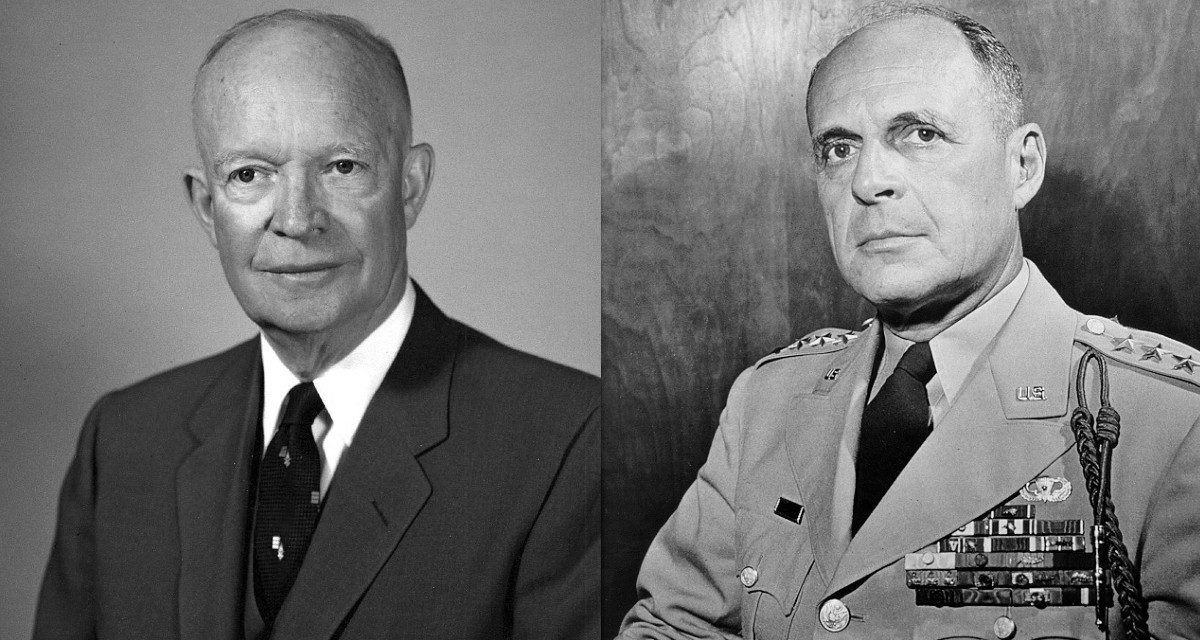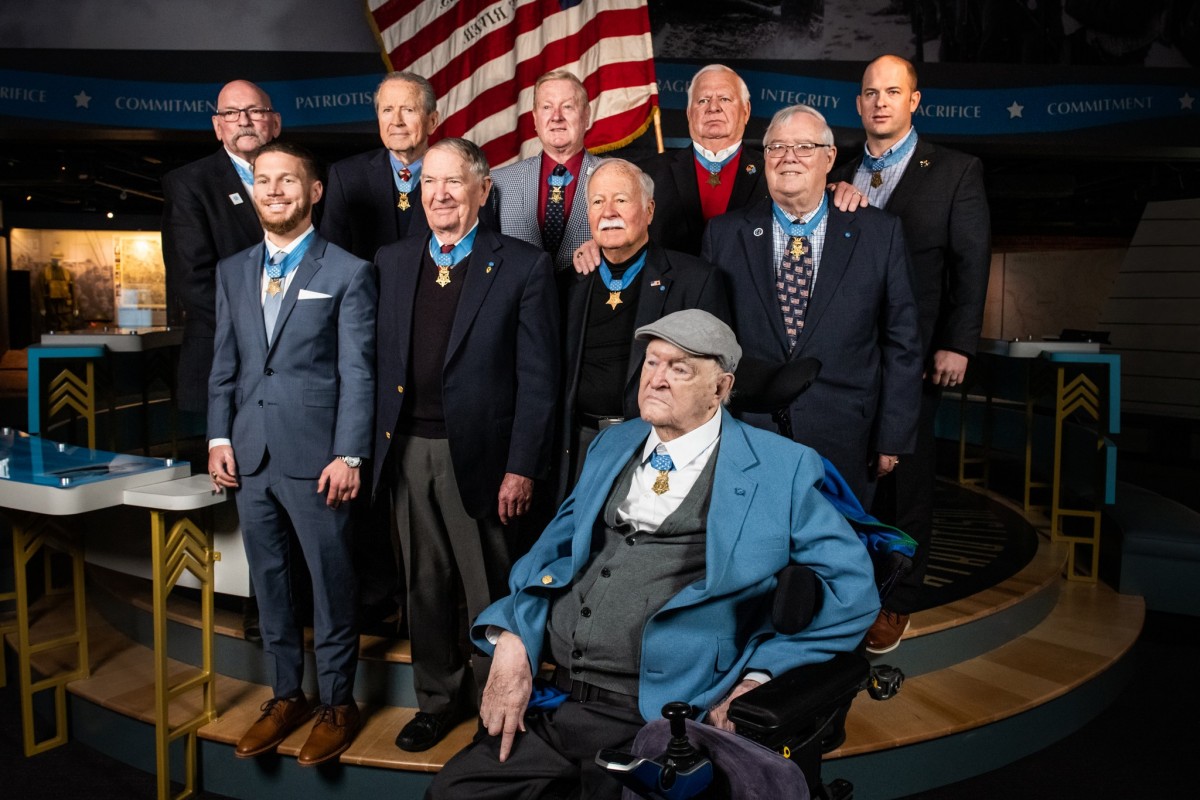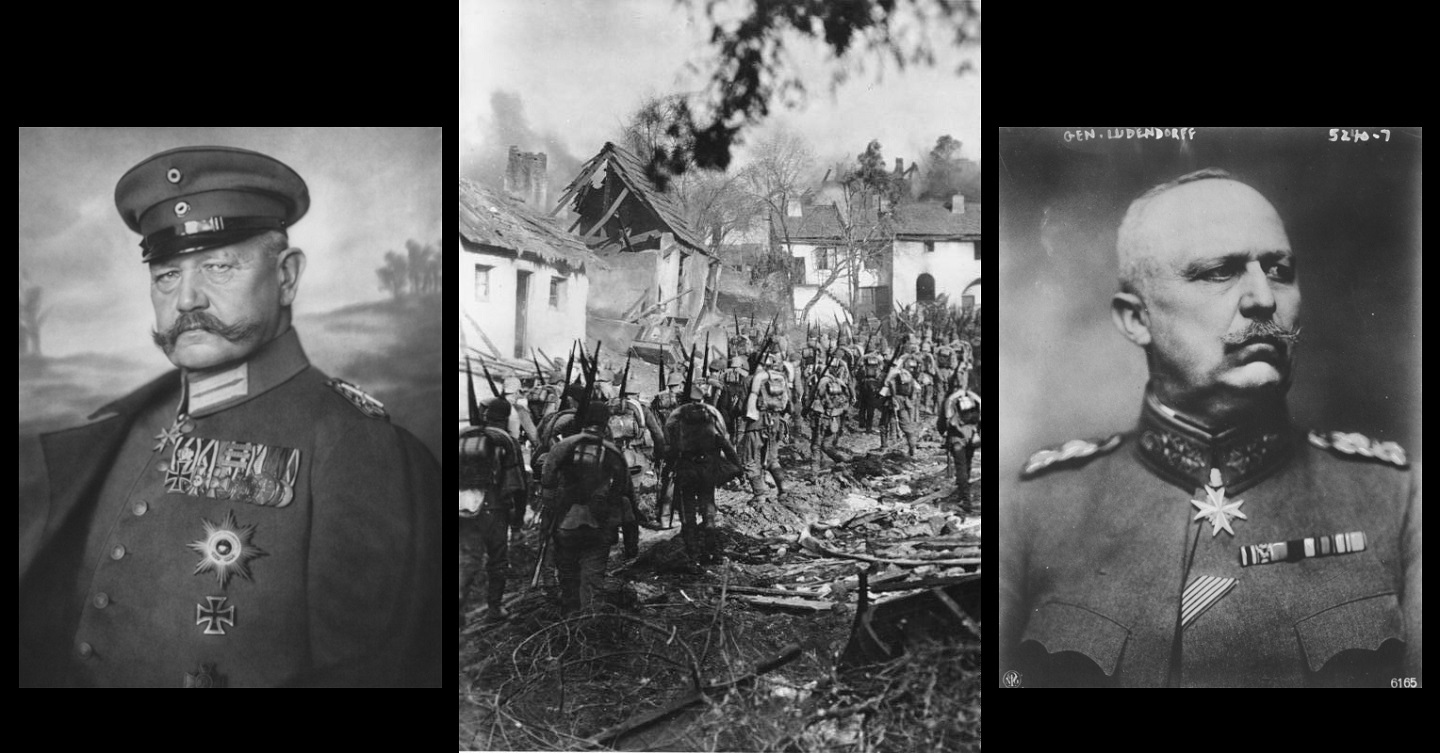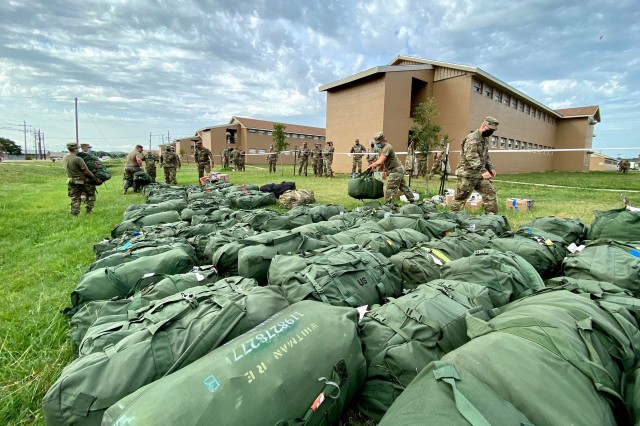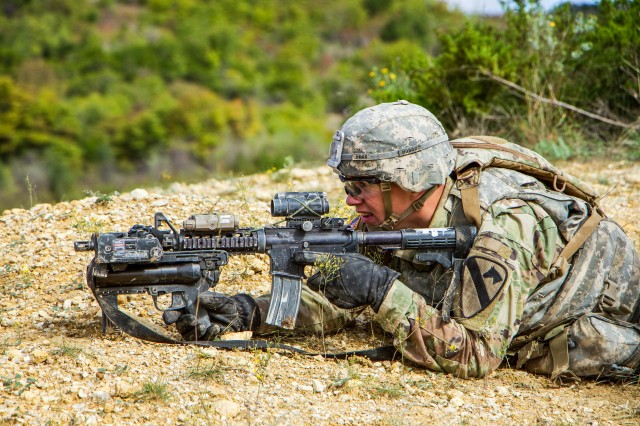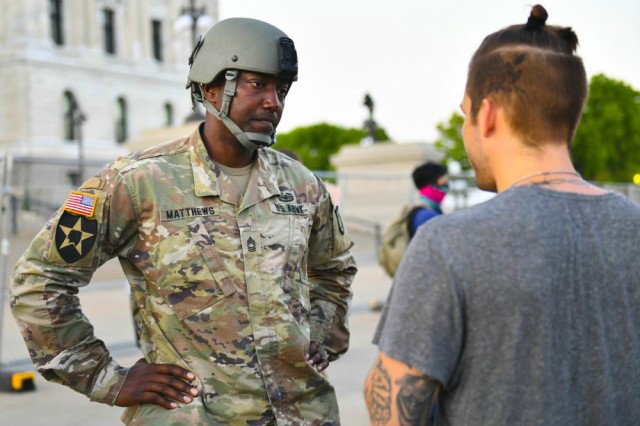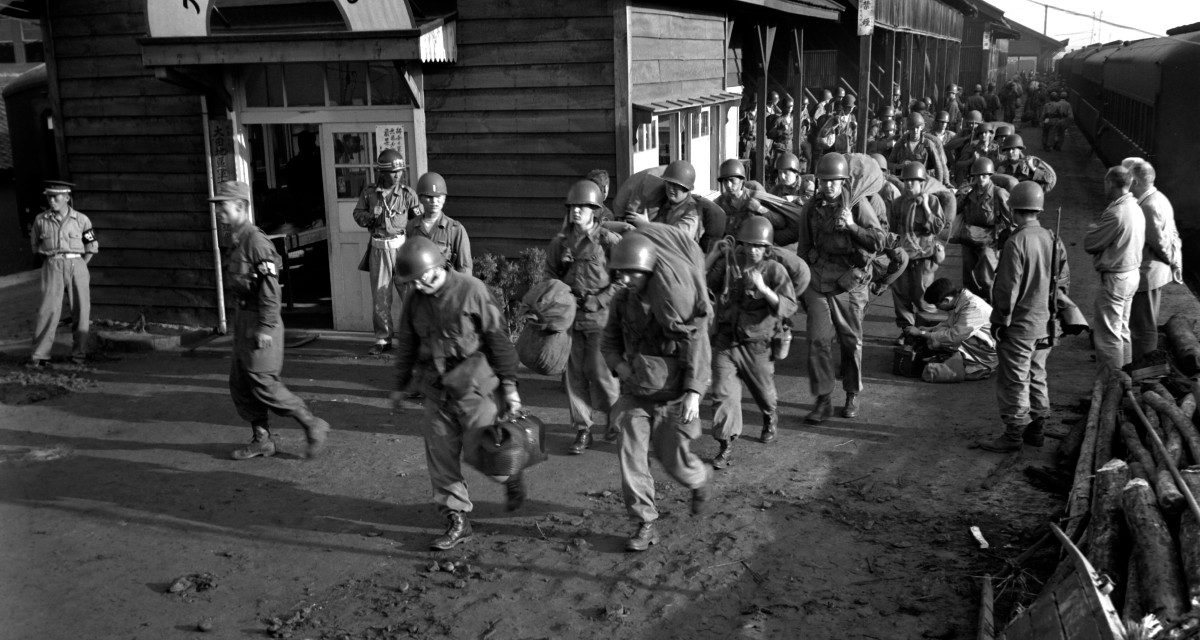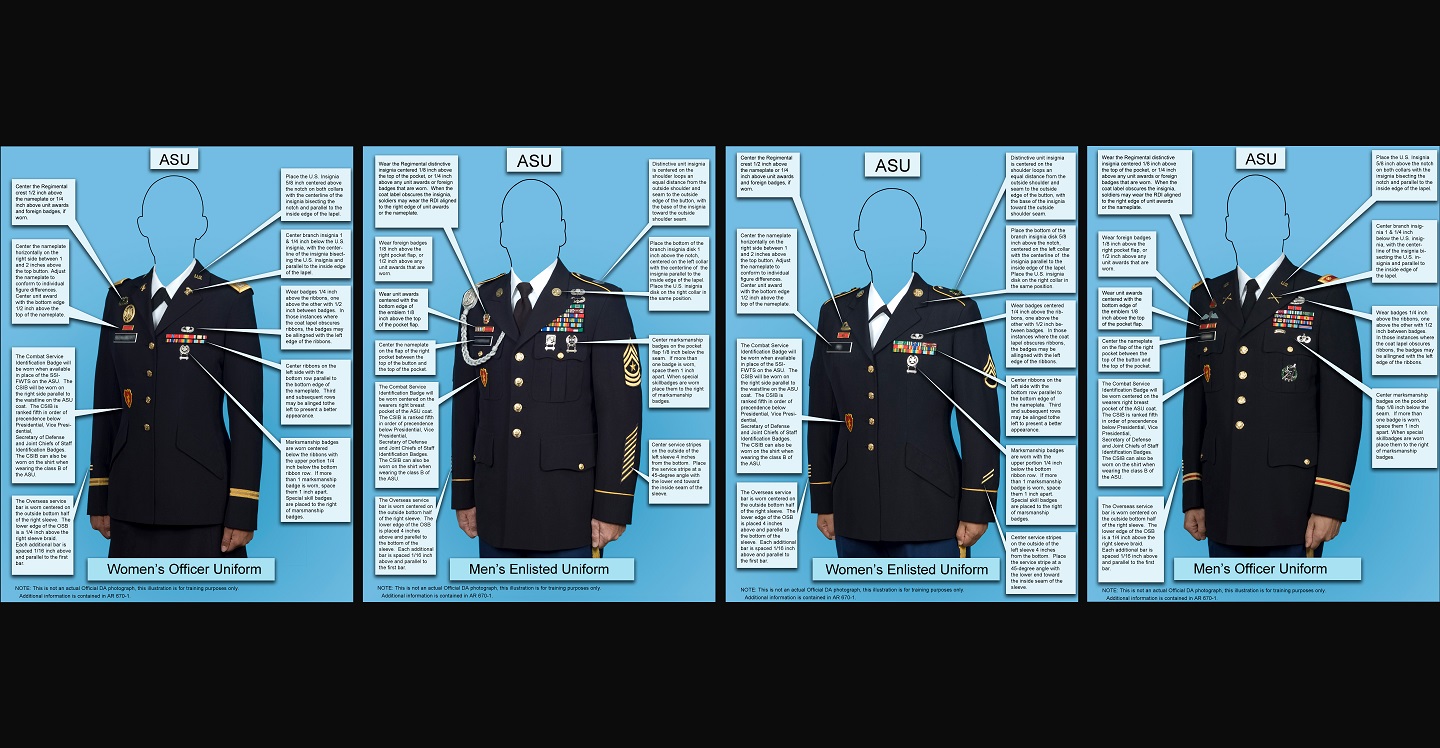Impossible Loyalties/Irreconcilable Differences
Steven L. Ossad
(This article was originally published in Army History, No. 91, Spring, 2014)
Whatever the relationships of individuals, the Civil War has always been described in terms of bitter separations. Only in civil wars and revolutions are the grand historical issues between people and states writ small in the dynamics among their families, but the fratricidal theme is not just a popular description without substance or irony. Mark Boatner’s classic Civil War Dictionary includes an entry entitled “Brother against Brother” that cites such complex examples of divided sibling loyalties as the Kentucky-bred Breckinridge family – a Yankee Breckinridge captured his Confederate brother outside of Atlanta—and the Buchanan brothers, both naval officers. At Hampton Roads on 9 March 1862, Franklin Buchanan, commanding the Confederate Merrimac, sank the USS Congress, sending his brother McKeen Buchanan to the bottom.1
Among the 160 general officers killed in action during the Civil War, split evenly between the two sides, there are also several examples of family members who fell in battle – Richard and Robert Garnett, Confederate generals and cousins, and Robert and Daniel McCook, Union generals and brothers.2 But, there is only one example of fallen brothers, both generals, on opposite sides of the conflict. The story of the Terrill brothers – William and James – is unique in American history as it echoed the nation’s agony on a personal level.3
It is scarcely possible to imagine a story as full of impossible decisions, divided loyalties, bitter family conflict, or tragic outcomes as that of the Terrill’s, and William Rufus Terrill, in particular. Scion of a proud and wealthy Virginia family, he is the tragic symbol of many who have been presented with irreconcilable choices: between home and nation, country and state, and between the wishes of people they loved and their own wills.
Schooled at West Point, trained as a soldier in the small cohesive and tightly knit antebellum regular army, and in love with the daughter of a prominent northern dynasty, William Terrill was the quintessential product of the Virginia gentry; refined, aristocratic, and proud, also bookish, reflective, sensitive, and loving. At the core, however, was his iron will. He was the kind of man for whom an oath is nothing less than words spoken directly to God. When he swore the oath to uphold the Constitution, defend the flag, and wear an officer’s uniform, it set him against his father, brothers, friends, and the very house and soil he loved; but for William there was only one choice.
His brother James Barbour Terrill faced no such anguish. He was a fervent, outspoken Southern patriot and faithful son of Virginia. A mediocre and rebellious student, he turned away from a military career to pursue the law, but before he could even enter that fray, the war interceded. A recent graduate of the Virginia Military Institute (VMI), he served with one of the most illustrious regiments in the Confederate army, but instead of achieving glory, his natural abilities as a soldier were overshadowed by the deeds of greater men. His vain efforts to rise above them led to selfish decisions and resentment among his men and colleagues and his career lagged even further.
These biographical details, though, are not particularly unique. The ending of the story is what sets the story of these brothers apart. Death in battle as generals ended the personal struggles of each, but left behind a bitter legacy for their families, who also suffered the loss of another son in the war along with many other relatives. To the ruin and devastation shared by many, theirs was a special case of “brother against brother,” and a phrase came to describe their special pain: “God Alone Knows Which Was Right.”4
Antebellum Life on Rose Hill
The Terrill family had deep roots in the soil and people of Virginia.5 Patriarch William Henry Terrill (1800–1877), son of William Terrill Jr. (1765–1811) was descended from English stock. His mother Jane Morton (b. 1773) was a distant relative of war hero President Zachary Taylor. Like his parents, William Henry Terrill was born and raised in Orange County, and after graduating from Creed- Taylor Law School, in Needham, Virginia, he headed out on his own to the Florida Territory to establish a legal practice. It was during this period that he also had his first brush with local politics, serving a single term in the territorial legislature.
Realizing quite soon, however, that Florida was not big or rich enough to satisfy his personal ambitions, he returned to Virginia and settled in Alleghany County. The presence there of warm pools of “healing waters,” especially near Covington—and the many property issues and transactions that resulted—provided ample opportunities for the growth of William Henry’s law practice, and he soon achieved a position of wealth and reputation. His contacts included many of the visitors to the resorts, which dotted the landscape, and whose guests included the most prominent citizens of north and south alike.
Soon after returning to his native state in 1827, he married Elizabeth Pitzer (1805–1858), a local Coving- ton beauty. Her family connections enhanced his professional standing and business relationships. As the young barrister focused on his career, Elizabeth assumed the role of hostess and was soon presiding over a rap- idly growing family at Rose Hill their home. A strong believer in the importance of education, as well as mastery of the social graces, she passed these values to her eight children, all but one of whom (Jeremiah Morton) survived early childhood. She was very close to her children and actively involved in all the details of their lives. They were also close to each other. Fortunately, her husband’s law practice and real estate investments provided ample means to support her ambitions for her sons, all of whom pursued higher education at prestigious universities – unusual for that time. The Terrill’s were known and respected throughout the surrounding counties, and the children were socially active and all attractive marriage candidates.
William Henry Terrill was the proverbial stereotype of the folksy, “silver-tongued,” anecdote-spouting, Southern country lawyer. Universally referred to as “the Colonel,” though he never held that rank in any military service (regular or militia), he was tall (6 feet 2 inches), portly (more than 250 pounds), and cut an impressive figure, both in and out of the courtroom. He was deeply involved in the affairs of his community. After settling near Warm Springs in 1838, William Henry became Commonwealth Attorney – essentially the county prosecutor, a post he held for more than a quarter century – and served a single term in the Virginia state legislature. His political buddies opened the door to more statewide involvement, and he served on the Board of Visitors of the Virginia Military Institute and the University of Virginia, both institutions attended by several of his children.
Cadet William Rufus Terrill, c. 851
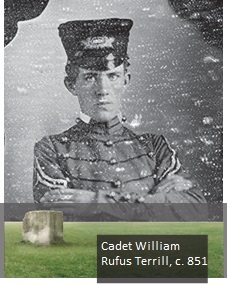
William Henry’s influence extended beyond that of traditional politicians despite the fact that he was one of few Southern Republicans and while a slaveholder was also known as a Unionist.6 His reputation for probity and unquestioned fairness were legendary. In one famous episode, William Henry prosecuted the son of a close friend with unrestrained fierceness and zeal after hearing talk that he was likely to go easy on the lad because of his relationship with his father.7 Because of such demonstrations of fairness, he was considered professionally reliable and recognized as a lawyer possessed of power, ability, and eloquence.8 During the Civil War, he remained on the periphery of Virginia politics, and through his various contacts remained connected to the governor’s office.9 His hopes that those connections would benefit his sons, especially his second born, would be bitterly disappointed.
From Rose Hill to West Point
William Rufus Terrill was born on 21 April 1834 in Covington, Virginia. From a very early age he wanted to be a soldier, and his parents supported that ambition. In 1849, though just fifteen years old, his father arranged an appointment to the U.S. Military Academy at West Point. Even in his teens, the face William showed to the outside world was severe, serious, some might even say puritanical. By the end of his first semester, Terrell had received only five demerits, an incredibly small number that placed him at the top of his class in soldierly deportment. He soon acquired a reputation for discipline and self-control similar to that of West Point Superintendent Robert E. Lee, a distant cousin, who had passed through four years at West Point without receiving a single demerit – a record never since equaled.
William’s outward aristocratic demeanor and seeming grimness, however, masked a more vulnerable and uncertain nature. His letters home reveal a sensitive and homesick boy who found the pain of separation— especially from his mother—difficult to bear. Complaining about the lack of letters from her in one exchange, his tone is fragile, wounded, almost pleading. His letters are openly affectionate; he wanted nothing so much as to please her and make her proud. Following publication of the initial academic rankings—which placed him 16 of 52—he vowed in a letter to her that by the end of the academic year, he would rank higher.10 That vow remained unfulfilled despite hard work and dedication. At graduation, his class ranking remained exactly where it stood at the end of his first term. His exemplary demerit record, however, did not survive a brief but redeemable bout of drinking and smoking.11
He was especially close to his older sister Emily (1832–1906) and wrote to her of his longing for the peacefulness of their home and his struggle to do well and fit in at West Point. In July 1849, just before William was to re- port to the Academy, Emily had married VMI graduate (1844), Mexican War veteran, and future Confederate Col. George Alexander Porterfield (1822–1919). Emily’s older brother, Dr. George P. Terrill, also a graduate of VMI (1849) and active in alumni affairs, had introduced the couple.12
William was fond of Porterfield and found it easy to talk to him. In his brother-in-law, he found a congenial and well-informed interlocutor, schooled in military science and the realities of combat, as well as politically aware. They spent many hours discussing the affairs of the day, as well as more personal and parochial concerns, and maintained their friendship and an active correspondence throughout the next decade.
The summer of 1851 was especially pleasant for William, as Rose Hill buzzed with activity centered on the social lives of his brothers, and the frequent visits of the sisters and their children. Soon, however, the idyllic surroundings and general pleasant- ness of life in the big house gave way to terrible anguish. In early August of 1851, just as William was preparing to return to West Point, his oldest sibling Sarah Jane (1828–1851), wife of neighbor and family friend William H. McDonald, died suddenly a few months after giving birth while at Rose Hill. The loss hit the family hard, but the young cadet had little time to mourn. By early spring, he was back at West Point facing the rigorous life of the Academy.
Inspite of the difficulties at home and the normal academic pressures, William was beginning to feel more at ease. The intellectual challenge was especially rewarding and he excelled at mathematics and the study of literature. He visited the library often, frequently spending his weekends there, and developed a hunger for historical novels.13 He was starting to loosen up a bit and began to shed some of the grimness that characterized his outward demeanor. He certainly looked like the ideal cadet and gentleman, “of good stature and well-formed. His hair was flaxen and waving [sic], his eyes a tender blue, his complexion rich, and his whole expression kind and gentle, but downright and decided. He had a winning frankness of manner, a steady cheerfulness under all circumstances, and a native cordiality which made it easy to like him. His intellect was clear, practical and judicious.”14
Library of Congress
However, even if he was mellowing, William’s appearance, background, and personality were bound to antagonize some, especially those who had an instinctive dislike for men of his social rank or regional origin. On 9 September 1851 in an episode still famous in West Point history, Cadet Sergeant Terrill was involved in an incident with Cadet Private Philip H. Sheridan—then a member of the class of 1852—in what the latter described as “a quarrel of a belligerent nature.”15 To say that Sheridan was the opposite of Terrill in almost every respect is no exaggeration; the imagination struggles to conjure two greater antagonists wearing the same uniform. A short, belligerent, naturally defensive, and dirt-poor Irish kid from New York, Sheridan was the antithesis of the tall, aristocratic, well-bred Virginian. In retrospect, confrontation was inevitable.
During a drill on the parade ground, Terrill was performing the duties of the “file closer” and ordered the pugnacious and prickly Sheridan to “dress”—in military terms, to get closer to the man to his front. Sheridan took immediate offense, both with Terrill’s order, and as he later explained, especially his tone, believing he was already properly placed in the line. Without comment or warning, Sheridan thrust his bayonet-tipped rifle toward Terrill, shouting, “Damn you sir, I’ll run you through.” After getting a grip on himself—all the while hurling threats and insults against the courtly Southerner, who was, after all, his superior—Sheridan sullenly returned to the line.
The next day, after learning he had been put on report—as was required— Sheridan again accosted Terrill, this time completely losing his self-control and striking the higher-ranking cadet on the side of his head. This attack took place right in front of the barracks and in full view of a number of bystanders. After a scuffle, in which Sheridan was clearly at a disadvantage to the taller and heavier Southerner, the two cadets were finally separated. The subsequent hearing upheld Terrill’s claim that he had acted properly, that the attacks had been unprovoked, and that he had merely defended himself. Sheridan’s explanation that he had been insulted and provoked by the “improper tone” of his superior was summarily dismissed.
Given the violent nature of Sheridan’s actions, he had ample reason to feel lucky that he was suspended for only a year.16 However, he was not grateful for the lenient punishment, and his humiliation—though well deserved—was nearly as great as his hatred of the man who he held responsible for the entire affair. Sheridan’s reputation as a volatile “hothead”— and the story of the clash—followed the diminutive cavalry officer for a long time—until fate put him on a battlefield where his deeds created a reputation for brilliance that erased all previous questions about character.
Prewar Duty & Family Strife
Willaim Terrill graduated from the .S. Military Academy on 1 July 1853, placing in the top third of his class (16 of 52), one-third of whom were destined to wear the stars of a general officer during the approaching war.17 As was typical of those with his class standing, Terrill was commissioned a second lieutenant in the 3d Artillery, though the bulk of his service was with the 4th Artillery.18
His hardest duty was on the Kansas frontier, where rigorous field conditions, intensified by the virulent political tensions, had ripped the plains communities apart in a terrible foreshadowing. Although Terrill’s sympathies lay with the Southern position, the savagery of the slaveholder’s tactics and his support for the Union also wielded strong influence. He was relieved to be ordered to West Point as acting assistant professor of mathematics in academic 1855–1856, a position he held but briefly. Suddenly transferred to Florida in the summer of 1856, he saw action in the Third Seminole War. As in Kansas, the nature of the war and ordeals of field service on combatants, and suffering of civilians, was hard on the young officer. The final actions were a series of skirmishes between small, roving Seminole bands and units like Terrill’s Company F, 4th Artillery, which was stationed at Fort Brooke (near present-day Tampa).
Both of these prewar assignments were a foretaste of the ordeal to come and consciousness of that certainty weighed heavily on everyone. Terrill’s next posting, however, was a respite and took him for a time away from the pressures—personal and political—as- sailing him and the country. For two years, until the outbreak of the war, Terrill worked for the U. S. Coast Sur- vey, mapping important waterways, primarily in the Hudson River Valley close to West Point, with expeditions to the south, along the Florida coast, and into the Caribbean. He thoroughly enjoyed the work, which was person- ally and professionally satisfying. It appealed to his analytical mind, engineering training, as well as his love of tales of explorers. He performed well, earning the respect and praise of his superiors for his diligence, dedication, and “good judgment, industry and success amid many difficulties.”19 During this time, Terrill was also under- going an evangelical conversion that deepened his relationship with God and church. Such spiritual undertakings were not uncommon during this fervently religious time.
His happiness and peace of spirit was short-lived. Back in Virginia, the family was passing through yet another period of pain and loss. John Allen Terrill (1839–1858), youngest of the surviving Terrill children, and considered the brightest star and most gifted of all, was at the University of Virginia when he was felled by typhoid fever just after New Year 1858. Alarmed by the report of John’s illness, his parents immediately journeyed to Charlottesville, his mother remaining to nurse her son, all to no avail. John passed away in his mother’s arms on 12 January 1858 and was buried next to his brother Jeremiah Morton Terrill at Rose Hill.20
Elizabeth was heartbroken at the loss of yet another child. Weakened by grief, she took ill soon after, felled by the dreaded fever. Within weeks she, too, was gone. It was a devastating loss for the entire family, especially William, who was shattered by the double blow. He adored his mother and was inconsolable, pouring out his grief in letters to his sister, letters that seem virtually stained with tears. However, the demands of the Army recognized neither grief nor private pain, and William’s mapping assignments were demanding.
Back at Rose Hill, “the Colonel,” gradually moved on with his life. Within a year of Elizabeth’s death, he was courting Miss Rachel Hamilton Scott, a widow from Covington and family acquaintance some years his junior. Not everyone was pleased to see the blossoming romance, and feelings among his children were uniformly negative. William was troubled by the relationship, particularly when it became apparent that his father intended to marry Rachel. In his correspondence with his brother-in-law George Porterfield, William spoke bluntly about his feelings, so much so that George feared that William might clash irreparably with his father. Soon, however, William began to gain some perspective, and backed off his resistance, writing George that while he did not favor the marriage and had actually discussed his reasons with his father, he would no longer oppose it and would “treat his wife with all the consideration due to her as a lady and my father’s wife.”21 The family discussion ceased when “the Colonel” married Rachel in 1860. At the time everyone accepted it, or so it seemed.
William was, during this period, involved in his own love affair. Through his continuing association with West Point, he met and began to court Emily D. Henry (1840–1884). She hailed from a very distinguished and well- connected Northern family that had achieved both military and political prominence. They likely met at the funeral for her father, William Seaton Henry (1816–1851), a renowned graduate of West Point (1835) and a veteran of the Mexican War. A hero of the Monterrey Campaign, his postwar book about his experiences, Campaign Sketches of the War with Mexico (New York, 1847), received widespread acclaim and became a best seller, but he did not live long enough to enjoy the fame. He died at age thirty-four, leaving behind three small children and a young widow, Arietta, daughter of Daniel Tompkins, a former governor of New York and the fifth vice president of the United States.
Emily’s brother, Guy Vernor Henry, following in his father’s footsteps, graduated from West Point in May 1861, and went on to win great renown in the Civil War (receiving a Medal of Honor), the Indian campaigns, and finally the Spanish-American War, eventually rising to major general and serving as governor of Puerto Rico. Sharing the bond of West Point and the chosen career of soldier, “Fighting Guy,” as he was known in the service, quickly drew close to his brother- in-law. Once again, a brother-in-law provided emotional and professional support when William’s relationship with actual blood family was fracturing. That Guy was a Northerner just extends the irony.
As sectional political divisions intensified, so too did personal strains and resentments among the Terrills. Some of the younger members of the family—especially William’s younger brothers Philip and James—felt that Emily Henry, Guy, and their prominent family and friends had “stolen” William away from his Southern roots, but his sister Emily did not share that view. The two Emily’s—Emily Henry Terrill and Emily Cordelia Terrill Porterfield—were especially close and maintained a warm, personal relation- ship as long as they lived. Oral family history reports that Emily Terrill sent the government payment she received on the death of her husband William to her sister-in-law, and maintained their correspondence even during the war, despite the obvious difficulties. One episode is particularly striking. During wartime in late 1863, Emily Henry Terrill went so far as to use her influence to help her in-laws—the enemy, after all—materially. She persuaded her mother, Arietta Tompkins Henry, to lobby Secretary of War Edwin M. Stanton, a family friend, on behalf of the Porterfields for the restitution of property seized from them by Union forces.22
The Concept & Cost of Allegiance
As the prospect of civil war grew more likely, William Terrill under- stood he would face an impossible personal choice, pitting two powerful and pure loyalties squarely in dialectic opposition. He loved the very soil of Virginia, which held the graves of his beloved mother and siblings. Except for being with Emily, Rose Hill—in the company of his father, sister, and brothers—was the only place William Terrill felt fully at ease and natural.23 If the worst came, he knew all of them would remain loyal to Virginia and stay with it, either in the Union, or to war. That much was clear, but he felt an allegiance they could not understand. From the moment William Rufus Terrill first stood on the parade ground at West Point, and in all the years since, the Army had been exerting as strong a pull as that which drew him to Rose Hill.
William had sworn an oath of allegiance to the United States, its army and flag, and these things—the ideas of nation, service, and union—were inseparable. This was a time when a man’s oath was like a tangible, living thing. Once given, an oath had a permanence and power that could not be diminished. Offers of rank and position proffered by Virginia’s governor could not sway him. As the conflict drew inexorably closer, he wrote to his father, “As long as I have a country and a government to serve I wish to be true to it. Were I to be false to one I could hardly be a valuable acquisition to another.”24 And of course, there was his wife Emily. She would never turn her back on her home or country. How could he fight against her?
In early March of 1861, William was on mapping duty in the waters near the island of Tortuga when Virginia began to consider whether to remain in the Union. His father was a front-row observer in the discussion over secession, and kept William informed by letter about the direction of the debate. “The Colonel” was a staunch supporter of Virginian sovereignty, so there was no question as to what his father would do if Virginia voted to secede. When that happened, William’s father and three brothers quickly declared their loyalty to the Confederacy and were among the first to seek service in its forces. William was also offered a commission for very high-level service, but after agonizing reflection and heated family discussion, he made his choice. “I am as I have ever been true to my oath, true to my country—and true to the flag that floats over [sic], whose folds I should prefer to be my winding sheet rather than see the dis- solution of this once glorious country.”25 He would remain loyal to the Union, but it was a decision that cut into the flesh of his family and their anger was deep, raw, and could not be assuaged.
News of the terrible decision—and the Terrill family’s reaction—soon reached the officer corps of the small, tightly knit Regular Army, which would become the core of a massive, industrialized military machine. Alexander D. Bache, who had been superintendent of the U.S. Coast Survey and had great personal affection for his young subordinate, was particularly moved. Describing his former aide as “a man of action, industrious, reliable, of good judgment and temper,” 26 Bache wrote to Lt. Col. George W. Cullum, then–chief aide to Commanding General of the Army Winfield Scott, to recommend the young officer and request William be transferred to the Western Theater. In support of his petition, Cullum for- warded a copy of “the Colonel’s” last letter to William, evidence, he noted, of the kind of pressure employed to induce William to abandon his flag and country.
In this letter, “the Colonel” uttered words that resonated on some terrible, biblical level. Promising to remove his son’s name from the family rolls, “the Colonel” threatened that Virginia will “know how to deal with traitors,” and in a ghastly foreshadowing of the nightmare to come predicted, “you will never be permitted to revisit your native state but to die.”27 Rachel, a fierce sup- porter of secession and now William’s stepmother, vilified his decision and labeled him a traitor. Of course, Rachel had reasons other than politics for such harsh feelings toward her not-much- younger stepson. She certainly knew of William’s resistance to her marriage to his father and his continued aloofness did not temper her anger.
Philip Mallory Terrill (1842–1864), William’s younger brother, was especially angry at the decision. His pain was even more pronounced because of his deep affection for his older brother, whom he characterized as “the darling of his family.” Writing to his sister Emily eight months after the beginning of the war with the latest news of their brother, his words were almost as harsh as his father’s. Philip described William’s “hireling service among the northern rabble” as having “severed forever the ties that bound him to us, and I cannot but feel that I had rather hear of his death than hear him branded (as he must inevitably be) a traitor to his country.” Realizing that the only way the decision could be reversed was through desertion— impossible to conceive for a man of honor like William—Philip resigned himself to permanent estrangement, and thereafter avoided any discussion of his brother.28
Promoted to captain on 14 May 1861, William Terrill took command of the newly organized Battery H, 5th U.S. Artillery Regiment. He spent the next several months in Washington training his men and preparing for action. In both capitals men were lobbying for appointments to command and calling in past favors. Finally, the request of Alexander Bache and the intervention of his well-connected mother-in-law29 with General Cullum yielded results, and William soon left for the Western Theater.30 It was a blessing; at least he would be spared the pain of fighting on his home soil, or against his father and brothers, all of whom were serving in some capacity in Virginia.
Baptism of Fire at Shiloh
At the end of 1861, William moved his well-drilled artillery battery to Louisville, Kentucky, where he took command of the artillery instruction camp. He remained there until the spring of 1862 when his unit mobilized for action in southern Tennessee. Both Maj. Gen. Ulysses S. Grant and Maj. Gen. Don Carlos Buell, the commander of the Army of the Ohio, were moving to cut the major water routes crucial to supplying the Confederate states. Southern forces under General Albert Sydney Johnson were moving to block them and had occupied the banks of the Tennessee River at Pittsburg Landing just north of the Mississippi border. There, near a small church called Shiloh, the stage was set for the bloodiest encounter yet of the one-year-old war.
Serving as chief of artillery for the 2d Division commander Maj. Gen. Alexander McDowell McCook—a year ahead of him at West Point and one of the famous “Fighting Mc- Cooks”—Terrill arrived at Pittsburg Landing early in the morning of 7 April 1862, the second day of the Battle of Shiloh.31 Maj. John Montgomery Wright, a staff officer aboard the same transport, recalled that as “the first streak of daylight came, Terrill, sitting on the deck near me, had recited a line about the rosy fingered dawn.”32 It was the oft-quoted opening of Homer’s Odyssey, one of his favorites, and apt considering his own personal journey.
Immediately after disembarking, Buell ordered Terrill’s battery to support Brig. Gen. William “Bull” Nelson’s hard-pressed Fourth Division. Nelson later praised Terrill for acting “with decided effect upon the turn of battle in that quarter.”33 McCook noted that in the brutal fighting that day, Terrill “fought his battery gallantly and judiciously and I commend him and his officers to my superiors.”34 At the height of the battle, Nelson ordered the 6th Ohio Volunteer Infantry Regiment to protect Terrill’s battery, screaming that it was the best in the service, and “must not be taken.”35 Even Terrill’s adversaries praised his performance; Confederate General P. G. T. Beau- regard, himself a West Point–trained artilleryman, attributed the survival of Col. Jacob Ammen’s 10th Brigade, one of Nelson’s units, to “the opportune arrival and effective use of Terrill’s regular battery.”36 It was an impressive performance for a man facing combat for the first time.
A General trains His Troops
After Shiloh Terrill’s battery saw brief action during the siege of Corinth, Mississippi, moving with the army into Kentucky. By this time, the commendations of his superiors had moved up the chain of command. There was still a great need for experienced West Point–trained professionals to command the ever-growing list of large formations in the expanding Federal army. Largely because of his service under General Nelson and the official endorsement of prewar engineering colleague and commander of the Department of the Ohio Maj. Gen. Horatio G. Wright, Terrill was named a brigadier general of volunteers on 9 September 1862.37 Soon after, he took command of the 33d Brigade, assigned to Brig. Gen. James S. Jackson, a well-connected Kentucky lawyer and congressman turned general, commanding the Tenth Division. This brigade was a newly raised outfit of just under 2,500 men, organized into four regiments and filled with raw recruits from Illinois and Ohio.38
A stern and impatient commander with no tolerance for idleness or slackers, he immediately instituted a rigorous training program during a late summer heat spell. It did not endear Terrill to his men. In addition, his cold and distant manner—archly superior some said—led to a feeling in the ranks that Terrill did not understand the volunteer soldier, especially the ordinary citizen from the North.39 In fact, many wondered why he was serving in the Union Army at all. A story circulated among the men under his command that Terrill’s father (mistakenly identified as a “parson”) had dispatched him to West Point with a Bible and the admonition that he should read it every day and always honor his oath of allegiance. That oath, the men believed—rightly, as it turned out— outweighed anything else, including family pressure to swear allegiance to the Confederacy.40
Very soon there was more reason to resent—even hate—the young brigadier general. During one of the hottest and most humid spells on record, General Jackson ordered an elaborate grand review in Louisville on 16 September. It was a disaster. More than fifty men fell out with sunstroke, dehydration, and exhaustion; a handful actually died. Anger directed at both Jackson and Terrill was so great that some soldiers were as anxious to aim their rifles at them as at the enemy. Bliss Morse, a young private in the 105th Ohio Volunteer Infantry Regiment, wrote to his mother:
Our Brig. Gen. Terrill is a tall light haired man with a coarse voice which makes him quite a target for the boys to mock at. He loves good liquors and beef for his table was well supplied with them while I was on guard before his quarters. The boys rather dislike him since that review down to Louisville. Some of them swore they would take his life. He heard of it—for the march used up a good many boys who have not got over it yet and did not amount to a row of pins.41
Terrill did have some enthusiastic supporters. As soon as he took over his brigade, he organized his own artillery battery formed mostly from the 105th Ohio Volunteers and a collection of eight artillery pieces.42 Under the command of Lt. Charles C. Parsons, an affable and competent young West Pointer from the 5th U.S. Artillery, the battery became Terrill’s pet project; some described it as an obsession. Incessantly training and drilling his makeshift collection of men and guns, Terrill, the professional artillery officer, was totally in his element and the men responded powerfully to his personal involvement.
Just a few days before Buell’s Army of the Ohio moved out, Terrill happened to meet Philip Sheridan, by then also a brigadier general and commanding an infantry division in Buell’s army. In his memoirs, Sheridan claims to have taken “the initiative toward a renewal of our acquaintance,” possibly to put their previous antagonism be- hind them on the eve of battle. Time had tempered the volatile Sheridan, who, after a decade of reflection on the incident at West Point, noted:
At the time I thought, of course, my suspension a very unfair punishment, that my conduct was justifiable and the authorities of the Academy all wrong, but riper experience has led me to a different conclusion, and as I look back, though the mortification I then endured was deep and trying, I am convinced that it was hardly as much as I deserved for such an outrageous breach of discipline. There was no question as to Terrill’s irritating tone, but in giving me the order he was prompted by the duty of his position as a file closer, and I was not the one to remedy the wrong which I conceived had been done me, and clearly not justifiable in assuming to correct him with my own hands.43
For professionals and volunteers alike, who knew of the incident—it was common knowledge in the ranks of Terrill’s brigade and certainly among the West Point graduates in Buell’s army —it was a tense moment. However, in a spontaneous gesture of fellowship, both men simultaneously extended hands in an act of reconciliation.44 For Terrill, a man who had alienated his family and closest friends by keeping faith with his oath to his country, it must have been a moment of great emotion. On the eve of battle, he thought, at least one great breech that had marked his life was healed.
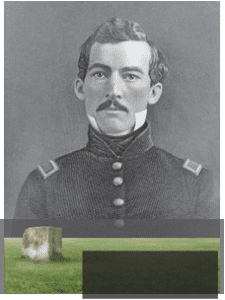
The Battle of Perryville
Confederate strategy during the fall of 1862 was dominated by attempts, for military and political reasons, to invade the important Border States. In the east, General Robert E. Lee’s magnificent Army of Northern Virginia entered western Maryland in early September, culminating in the Battle of Antietam on 17 September 1862. Lee withdrew after an all-day slugfest that cost both sides more than 25,000 casualties, the bloodiest single day of the war. But while the Union forces held the field, Maj. Gen. George B. McClellan, the Army of the Potomac commander, missed a crucial opportunity to cut off Lee, crush his army, and possibly end the rebellion.
In the Western Theater, separate columns under the overall command of Confederate General Braxton Bragg started heading north into Kentucky in August. By mid-September, Confederate forces held Lexington and Frankfort, controlled a large part of the state, and were close to a decisive victory.
By early October, Buell’s army had blocked some of the Confederate thrusts and was moving to confront Bragg. Both armies, parched by heat during one of the worst droughts ever recorded, and looking desperately for water, maneuvered around Perryville, Kentucky. On the evening of 7 October 1862, after some skirmishing around the hills dominating the town and the meager water sources, the senior officers and staff of Jackson’s 10th Division, part of McCook’s I Corps, met around a campfire for an informal chat. Terrill and his fellow brigade commander, Col. George Webster, traded lighthearted banter with Jackson.
As the evening progressed, the pleasantries gave way to more serious speculation about their prospects for survival in the coming battle. Perhaps to reassure each other about the outlook—their division was made up entirely of raw recruits, while the enemy army was comprised of hardened veterans—the discussion remained some- what abstract. With a combination of mock seriousness and frivolity, Terrill, the former mathematics instructor, suggested that with so many men on the field, their statistical chances of coming through the battle without serious injury were good.45 Later, however, in a more private conversation, Terrill expressed his trepidations to the chaplain, who admonished him for preparing for the worst. To which Terrill replied, “I have been prepared to die for a long time.”46
By early afternoon the next day, McCook had arrived on the field and deployed his two small divisions. At 1345, McCook ordered Terrill to take his brigade to a ridge on the extreme left of the Union line, anchored on Open Hill (also called Open Knob) and covered by Parson’s Battery. Terrill began the march right away, reaching Open Hill by 1400. His division commander, Jackson, joined Terrill just to the rear of Parson’s Battery and both men waited as the Confederates maneuvered in front of them. Within minutes Confederate Maj. Gen. Benjamin Cheatham’s division slammed into the exposed Federal northern flank, the main objective of their attack. Suddenly, and without any warning, Confederate Brig. Gen. George E. Maney’s veteran brigade— four regiments of Tennesseans and a regiment of Georgia boys—emerged from a ravine at the base of the ridge and poured a withering fire directly into Terrill’s Midwesterners. To some survivors it seemed as if the rebel soldiers had sprung up from the earth like the offspring of dragon’s teeth in Greek myth.47 One survivor described the bullets as “sounding like a swarm of bees running away in the hot summer air overhead.”48
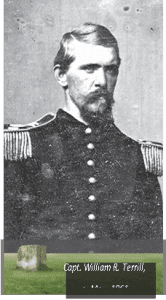
Parson’s guns showered the rebels with grapeshot and soon became the main target of the Confederate rifles and counterbattery cannon fire. The hill was a deathtrap. Men and horses began to fall quickly and within a few minutes of the opening attack, Jackson was struck twice, dying within minutes. Alarmed that his precious battery would be overrun, Terrill acted with desperation and ordered the green 123d Illinois Volunteer Infantry Regiment—organized just one month before—to charge down the hillside. They surged forward and just as quickly broke and fled under the pressure of the determined onslaught and the terror inspired by the rebel yell, leaving almost two hundred men on the blood-drenched slope. The desperate charge was a disaster and a major command blunder. Terrill, seemingly blind to the overall situation, had remained fixated on Parson’s guns as if their preservation was all that mattered.
The 105th Ohio Volunteer Infantry Regiment reached the crest and spread out around the battery just as the broken Illinois boys started streaming back up the hill. By this time, Maney had gotten about halfway up Open Hill before being halted by rifle fire and Parson’s guns, which by then were firing double loads of canister in the faces of the Confederates. Terrill realized that he would not be able to hold, and at 1515, he ordered Parson to withdraw. But it was too late. Five minutes later, Maney’s men reached the crest of the hill and Parson was able to escape with just one gun; the rest were captured.
Terrill, the proud artillery commander who had focused so much attention on his “own” battery, was crushed. His fine handiwork had been destroyed and his entire brigade was now in full retreat, streaming back and exposing McCook’s left—the flank of the entire army—to the enemy. Within minutes, however, Terrill rallied and was able to form a new line, once again taking position near some artillery pieces. It was none too soon as Maney had barely paused around Parson’s guns before renewing his attack, driving his men hard through a cornfield just in front of the Benton Road, where Union Col. John C. Starkweather’s 28th Brigade was strongly entrenched.
Robert Taylor, a soldier stationed nearby, watched in astonishment as Terrill removed his jacket, rolled up his sleeves, and began working one of the guns—perhaps the surviving piece of Parson’s battery. Just a few minutes later at 1555, Terrill was hit by shell fragments, which tore open his chest and soaked his blouse with blood. Maj. James A. Connolly of the 123d Illinois who also claimed—improbably to some—to have been standing on Open Hill near Parson’s Battery when Terrill was struck, saw his commander fall and hurried to his side. Recognizing Connolly, Terrill asked if the wound was fatal. The major, certain that it was, nevertheless answered, “Oh, I hope not, General.” Before they took him away, Terrill whispered, “My poor wife, my poor wife.”49
As a group of soldiers carried Terrill to a makeshift hospital set up in a private house, Maney’s troops crossed the Benton Road, forcing back Starkweather’s brigade. The victory, however, was short-lived; with- out support Maney was soon forced to withdraw, leaving the Federals in control of the crucial road. A short time later another Union brigade commander, Col. George P. Webster of the 34th Brigade, also fell. Later that night, Brig. Gen. William Rufus Terrill, age twenty-eight, succumbed to his wounds.
The senior leadership of the 10th Division was decimated. A jovial and abstract discussion of statistical probabilities had become the ironic epitaph for the front-line leaders of a fighting division. All three men who had sat around the campfire on the eve of battle chatting amiably and with detachment about their personal chances of survival were dead. So, too, were almost 1,400 other soldiers, and nearly 6,000 more lay wounded or were missing on the battlefield.50 Terrill’s brigade was reduced to a collection of badly mauled regiments. Altogether, Terrill’s losses were more than 500 men, almost a quarter of those en- gaged. It was an extraordinary loss for such a brief engagement.51 Darkness, the arrival of Union reinforcements, and a realization that he was facing Buell’s concentrated army and had evaded total destruction only by luck, had convinced Bragg to pull back.
The Other Terrill Brothers
The Battle of Perryville was over. It was counted a tactical victory for the rebels, but the strategic threat of an invasion of the North was over, for now. The failure of Robert E. Lee’s first invasion at Antietam just one month before ended the same way, with the Confederates still in the field, but failing in their strategy of forcing a political settlement through invasions northward in the Eastern and the Western Theaters. These twin setbacks in the autumn of 1862 spelled the end of the Confederacy’s best chance for success during the early years of the war.
Many other—and greater—battles followed Perryville, and the dead generals who fell there were soon forgotten. William R. Terrill, whose debut as a brigade commander was not impressive, lost the chance to absorb the hard lessons he could have drawn from his performance and later redeemed himself on other battlefields. Whatever promise he might have had as a commander was overshadowed by his mistakes. He passed into obscurity without victory or glory.
On the same day that his brother fell in battle, Confederate Lt. Col. James Barbour Terrill was tending to his regiment, the 13th Virginia Volunteer Infantry Regiment, which had been badly mauled in the fighting that summer and early fall. He had heard nothing of his brother William for more than a year. Born on 20 February 1838 in Warm Springs, Virginia, he had also followed the path of a professional soldier, graduating in 1858 from VMI near the bottom of his class (16 of 19).
Despite his mediocre record and a penchant for “unauthorized absences” when greater attractions beckoned, he gained the favorable notice of one eccentric West Point–trained artillery officer and professor of natural philosophy named Thomas J. Jackson, whom Terrill jokingly described to a friend as “a character, either a genius, or just a little crazy.”52 Jackson would go on to earn the sobriquet “Stonewall” as well as undying glory.
Instead of active service, however, upon graduation James chose to study law at Lexington Law School in Virginia, under its founder, the distinguished jurist John W. Brockenbrough, a friend of “the Colonel.”53 In 1856 he accepted a militia appointment as a major in the 5th Virginia Volunteer Cavalry Regiment arranged by Governor Henry A. Wise. A year later, James established his practice back home in Warm Springs. As war drew near, he faced no impossible choices, nor had he any doubts where his loyalty and duty lay. While his brother William agonized, James wrote a letter to Virginia’s governor, detailing his military experience and making “a formal tender of my services in a military capacity.”54 His request was quickly granted, and in May 1861 he was appointed a major in the 13th Virginia Volunteer Infantry Regiment.
James set about his duties with in- tense devotion, but also made time for his personal life. In early 1862, James married Charlotte Eucebia Drewry of nearby Chesterfield County. They quickly had two children, James Mercer (1862–1880) and Emily Barbour (1864–1943), but as his responsibilities grew Major Terrill had little time to spend with his young family. The 13th Virginia, which was under the command of Col. Ambrose Powell Hill, was continually in action. A legendary outfit in the increasingly famous Army of Northern Virginia, the 13th Virginia received universal praise, and was described by Con- federate division commander Maj. Gen. Jubal A. Early this way, “The Thirteenth was never required to take a position that they did not take it, nor to hold one that they did not hold it.”55 It was frequently called upon to do both.
Called “Major Terrible” for his iron discipline, James Terrill was not well liked, a striking similarity with his brother. It certainly did not help that he labored in the shadows of two gifted and talented predecessors: Hill, an exceptionally colorful and dashing West Pointer, and the immensely popular and competent Col. James Alexander Walker (1832–1901), a successful lawyer and politician. For three years, Terrill served as the second in command of the 13th Virginia. He was first cited for bravery on 11 September 1861 when, under command of his cousin, Col. J. E. B. Stuart, he led an infantry detachment in a highly successful raid at Lewinsville, Virginia, earning the commendation of Brig. Gen. James Longstreet for the “handsome use of his light infantry.”56
One year later, Terrill was promoted to lieutenant colonel and his regiment was assigned to the command of his old instructor, “Stonewall” Jackson, then campaigning in the Shenandoah Valley. Terrill’s regiment was then dispatched to the fight in the 1862 Peninsula Campaign, General McClellan’s attempt to capture Richmond by an amphibious landing on the Virginia Peninsula between the James and York Rivers. On four successive days of the Seven Days’ Battles, Terrill’s men fought hard in towns around Richmond, including at Gaines’ Mill, White Oak Swamp, and Malvern Hill. Later, at both Cedar Mountain and Second Manassas, James was again cited for gallantry.57 Both his division and brigade commanders cited Terrill yet again in May 1863 for his performance at Chancellorsville where, under his command, the 13th Virginia hurled back a Federal column that had broken through the Confederate right, threatening the entire Army of North- ern Virginia at its moment of victory.58
Finally, on 13 May 1863, just days after Chancellorsville—probably Lee’s greatest battlefield victory—James Walker, now a brigadier general, took command of the Stonewall Brigade. Terrill was promoted to colonel and took command of the 13th Virginia.59 These changes to the command structure came at a time of great upheaval and dissension within the ranks of the regiment. Walker departed right after initiating a request to transfer the regiment to the cavalry, a very popular idea among the troops. Strongly supported by most of the other senior officers, the rank and file were motivated by their positive feelings for their earlier experience under J. E. B. Stuart, and no doubt by the glamour and reputation of the mounted service.
Stuart said of the regiment, “I never asked them to do anything they did not do,” was supportive and issued an official letter announcing the imminent transfer to his command as soon as adequate mounts were avail- able.60 Terrill, however, opposed the move and effectively ended it. Many felt that personal ambition was at the heart of his opposition. It was well known that the chances for promotion to general officer rank were much greater for regimental commanders in the infantry than the cavalry. In spite of the hard feelings, however, Terrill was respected as a combat leader and admired for his skill in handling men and instinctive ability to read the terrain and dynamics of battle. One critic assessed James Terrill as “one of the ablest tacticians in the Army.”61
Assigned as the provost guard at Winchester, Virginia, he missed the Gettysburg Campaign and its aftermath, but Terrill’s men were back in action for the fighting in the Wilderness, and at Spotsylvania Court House. By this time, Western Theater hero Ulysses S. Grant had taken command of Union forces and had begun the grinding and bloody attritional fighting that would overwhelm the Confederacy and end the war. On 30 May 1864, during the opening stages of the Cold Harbor Campaign, Terrill took temporary command of Brig. Gen. John Pegram’s brigade. It was clear to all that it was just a matter of time before Terrill would be promoted to general.
Personally leading the charge near Bethesda Church on 30 May 1864, Terrill attacked a force of Federal cavalry operating with Maj. Gen. G. K. Warren’s V Corps. By late afternoon, Terrill’s men succeeded in scattering the enemy and captured several guns, but the young commander was badly wounded. With every field grade officer of the brigade killed or wounded, Terrill was called upon to lead a desperate bayonet charge against the enemy. He was shot in the head and killed instantly.62 His body, first covered with a layer of sand, was identified by Union officers and buried on the field where he fell.63 The next day, his promotion to brigadier general, which had already been confirmed by the Congress of the Confederate States, was approved by President Jefferson Davis to date from 31 May 1864.64 Once more, Rose Hill was filled with tears and the anguished cries of mourning women.
At least one family member did not allow the loss of his brothers to temper his hatred for the treacherous enemy. When war broke out, Philip Terrill, the youngest surviving brother, left the University of Virginia and enlisted in the 25th Virginia Volunteer Infantry Regiment, later transferring to the 12th Virginia Volunteer Cavalry Regiment as a lieutenant. From the beginning, he vowed vengeance against the hated Yankees for this mortal blow to his family. The death of his once favorite brother William had done nothing to soften Philip’s political convictions. Perhaps Philip’s desperation to “even the score” made him reckless, and just six months after James was killed, on 12 November 1864, Philip was mortally wounded at the Battle of Cedar Creek near Winchester, Virginia.65
War had not only torn a proud family apart, but it had virtually destroyed the male line. The only one left was Dr. George Parker Terrill, who held a medical degree from University of Pennsylvania and had also graduated from VMI in 1849. Although poor health restricted his activities, he served in Salem as a colonel and post surgeon in the 157th Regiment, Virginia Militia, and lived for another twenty years practicing medicine, teaching, and publishing a newspaper.66
A Family Torn Asunder
The Terrill family, bereaved and devoid of property and income, was a collection of grieving widows, a shattered sister, a single surviving son, and a proud but broken old man. As a former “official” of the Confederate government—Provost Marshal for Bath County—“the Colonel” could not practice law. Until the revocation of the so-called iron clad oath for certain occupations—which required one to swear that he had proffered no aid to the former government—“the Colonel” was deprived of the means to earn a livelihood. He was nearly seventy years old when he was once more allowed to practice law in the county court.
Conditions were difficult for other family members, as well, including Emily Porterfield and her family living in Charles Town, West Virginia. George Porterfield had commanded the small Confederate force that was defeated at Philippi on 3 June 1861 in a brief encounter thereafter referred to as the “Philippi Races.”67 As a well- known, high-ranking Confederate officer, George faced financial and other problems. Sustenance came from William’s widow Emily, who provided emotional and material support to her former “enemies.” Undeterred by the restrictions of Reconstruction, she quietly helped support her sister-in-law’s family financially until George was able to establish a new career as a banker. 68 The story of the two Emilys and the two brothers-in-law points the way toward eventual postwar reconciliation, in families and in the country.
“The Colonel” remained a tragic figure. Strolling through the streets of Warm Springs carrying his walking stick topped with a fine silver bob, he was a reminder of both pain and pride. When asked about the unique ornament atop the cane, he replied, “It is all I have left from my fortunes.”69 In a final devastating stroke of bad luck, after his reinstatement at the bar, his beloved home of Rose Hill burned to the ground in 1873, under questionable circumstances. Many suspected revenge by some long-forgotten adversary. Others felt that political motives were at work. The cause was never established. Mansion and contents were lost, except for an antique horsehair sofa that still bears the marks of the fire.70 With his home gone, and increasingly beset by illness, “the Colonel” could no longer take care of Rachel or himself. Rachel went to live with her children, and when she died in February 1877, “the Colonel” was in such bad health he could not attend her funeral. He died at Emily’s home in Charles Town on 28 November 1877.71
The Growth of a Legend
Decades after the war, a story—a legend, really—spread from Bath County about the final resolution of the terrible breech in the Terrill family. Like other such tales, even serious historians (including this author) picked it up and repeated it uncritically without checking details deeply enough to verify accuracy and those who tried could not do so.72 This is how the tale was told.
Grief-stricken, his face locked in a grimace of sorrow, the old man slowly removed the canvas cover draping the granite headstone. Sons are fated to bury their fathers—except in war—but in this terrible moment, a father stood over a monument to three of his sons, all fallen in battle. Slowly, in a voice trembling with unfathomable emotion, the distinguished lawyer, legislator, and orator eulogized his children. Every member of the solemn gathering— their own pain from the loss of loved ones still raw even after a decade—watched with a full appreciation of the scale of the tragedy that had ripped the family, and their country, apart. The old man then read the inscription aloud: This monument erected by their father; God Alone Knows Which Was Right.
Except the story was fiction.
Within days of his death on the Perryville battlefield, Brig. Gen. William R. Terrill’s body had passed through the Sanitary Committee in Louisville and, via Cincinnati, to Reading, Pennsylvania, hometown of his wife Emily. There, on 17 October 1862, after a military funeral attended by local dignitaries, he was laid to rest in the Charles Evans Cemetery in a plot belonging to James McKnight, a distinguished citizen and artillery officer in the Mexican War. His body remained there until Emily’s death in February 1884, when the couple was laid to rest together in the cemetery at West Point.73 Several days after James was killed, “the Colonel” recovered his son’s body and arranged for burial near Mechanicsville.74 Nothing is known about the fate of Philip’s remains.
There has never been a fine stone marker, nor a single grave holding the three Terrill brothers, nor is there any actual monument honoring their memory and the agony of their family. The story of how the legend gained credibility, however, is itself fascinating, and speaks to the power of the Civil War to capture the American imagination and shape legends and memorials—real and imagined—even a half-century after its end and up to today.
According to a local attorney, John W. Stephenson (1850–1921), who knew “the Colonel” in old age, the monument was “built” in Stephenson’s office.75 He described the tale to a visitor in 1918, who in turn reported it to a local newspaper. At the end of the nineteenth century, the famous correspondent Richard Harding Davis (1864–1916) summered regularly at the newly renovated Homestead Resort in Hot Springs. Davis was an acquaintance of Stephenson and frequently visited his office in search of lively conversation and tidbits of gossip he could use in his column for Harper’s Weekly, where Davis served as editor.
One morning the conversation turned to the eccentricities of “the Colonel” and the tragic brother generals. Davis, believing that they deserved to be remembered in some grand way, wrote a story for his newspaper imagining a funerary monument—a cube inscribed on opposite sides to the memory and glorious deaths of the two brothers. Between the opposite faces of the cube, facing the viewer, the imagined inscription would read, “God Alone Knows Who Was Right.” That is how the story began.76
To say that the monument is fiction, however, is not the same as saying that it does not exist as a powerful image of the sort that attaches to our national imagination, especially about tragedies. The poignancy of the fate of the Terrills, and the notion of absolute loyalty and fealty to duty that their story evokes, are both monument and warning, each harder than marble. Their story is testimony to the private struggles and extraordinary losses and sacrifice among those who rallied to defend their way of life—and the inherently and absolutely irreconcilable claims by either side in a civil war. All that matters is what hap- pens after, and in that regard the story of the two Emily’s is as inspiring as any patriotic legend.
-
Mark Mayo Boatner III, The Civil War Dictionary (New York: David McKay Co., 1959), p. 89.
-
Steven L. Ossad, “The Fighting McCooks,” Civil War Magazine 22, no. 77 (2007).
-
Russell K. Brown, Fallen in Battle: American General Officer Combat Fatalities from 1775 (New York: Greenwood Press, 1988), pp. 163, 218.
-
Richard L. Armstrong, “God Alone Knows Which Was Right”: The Blue and Gray Terrill Family of Virginia in the Civil War (Jefferson, N.C.: McFarland, 2010).
-
Margo Oxendine, Recorder, 12 Jan 1989–2 Feb 1989; Richard L. Armstrong, The Civil War in Bath County, Virginia (Hot Springs, Va.: R..L. Armstrong, 1994).
-
Ltr, William R. Terrill to William H. Ter- rill, Mar 1861, Bath County Historical Society Collection, Va. (hereafter cited as BCHSC).
-
Ibid.
-
Ibid.
-
George A. Moffett, “Obituary of Col. William Henry Terrill,” Lexington Gazette [Dunsmore, W.Va.], 18
Dec 1877.
-
Ltr, William R. Terrill to Emily Terrill Porterfield, 20 Jan 1850, BCHSC.
-
Ltr, Robert E. Lee to William H. Terrill, Sep 1852, BCHSC.
-
It is also possible that Emily was intro- duced to her future husband by her father who served on the Board of Visitors of Virginia Military Institute. Telephone conversation, Mrs. Philip Terrill Porterfield III with author, 21 Jan 2006.
-
Ltr, William R. Terrill to Emily Terrill Porterfield, 1850, BCHSC
-
“Tribute,” New York Times, 8 Feb 1863.
-
Philip Henry Sheridan, “Personal Mem- oirs of P. H. Sheridan,” 1888, available at http:// pattonhq.com/militaryworks/sheridan.html; Roy Morris Jr., Sheridan: The Life and Wars of General Phil Sheridan (New York: Crown, 1992), p. 21.
-
Morris, Sheridan, p. 22.
-
The class of 1853 produced ten Union and five Confederate generals, including such luminaries as James B. McPherson, the highest- ranking Union Army general to fall; John Bell Hood, a Confederate general; and Joshua W. Sill, a Union brigadier general who was killed in action.
-
George W. Cullum, Biographical Register of Officers and Graduates of the U.S. Military Academy at West Point, N.Y. (New York, 1891).
-
“Tribute,” New York Times, 8 Feb 1863.
-
Both graves have disappeared. The fallen brother burial myth likely has its roots in these family burials. Personal communication, Richard Armstrong, with author, 10 Jan 2014.
-
Ltr, William R. Terrill to Mr. George Porterfield, n.d., BCHSC.
-
Ltr, BG Edward Canby to Mrs. William R Terrill, 9 Jan 1864, BCHSC.
-
Ltr, William H. Terrill to Emily Porter- field, 18 Jul 1856, BCHSC.
-
Ltr, William H. Terrill to William R. Terrill, 9 Mar 1861, BCHSC.
-
Ibid.
-
Ltr, Alexander Bache to George Cullum, 20 May 1861, Special Manuscripts Collection, U.S. Military Academy Library, West Point, N.Y.
-
Ltr, William H. Terrill to William R. Terrill, Mar 1861, BCHSC and U.S. Military Academy Library.
-
Ltr, Philip Terrill to Emily Porterfield Terrill, 7 Dec 1861, BCHSC.
-
James Hillard, “You Are Strangely Deluded”: General William Terrill,” Civil War Times Illustrated 13, no. 10 (February 1975): 15; Kenneth W. Noe, Perryville: This Grand Havoc of Battle, (Lexington, Ky.: 2001), p. 186. Noe claims that Terrill’s mother interceded to arrange the transfer, but this is impossible since his mother passed away in 1858.
-
Hillard, “You Are Strangely Deluded,” p. 15.
-
Steven L. Ossad, “Personality: ‘The Ter- rill boys fought . . .,’” Military History (October 2005): 17–20.
-
Maj. J. Montgomery Wright, Assistant Adjutant-General, U.S. Volunteers, “Notes of a Staff-Officer at Perryville,” in Battles & Lead- ers of the Civil War, vol. 3, pt. 1 (New York: Facsimile reprint of the Century Co. edition, 1887–1888), p. 61.
-
The War of the Rebellion: A Compilation of the Official Records of the Union and Confed- erate Armies, (Washington, D.C.: Government Printing Office, 1880–1901), ser. 1, vol., 10, pt. 1, p. 294. (Hereafter cited as OR.)
-
Ibid., p. 304
-
Wiley Sword, Shiloh: Bloody April (Day- ton, Ohio: Morningside, 1988), p. 394.
-
General P. G. T. Beuregard, C.S.A. [Con- federate States of America], “The Campaign of Shiloh,” in Battles & Leaders of the Civil War, vol. 1, pt. 2 (New York: Facsimile reprint of the Century Co. edition, 1887–1888), p. 593.
37. OR, ser. 1, vol. 16, pt. 1, pp. 907–08.
-
William R. Terrill’s 33d Brigade was as- signed to the 10th Division (Brig. Gen. James R. Jackson, killed in action), I Corps (Maj. Gen. Alexander McCook), Army of the Ohio (Maj. Gen. Don Carlos Buell).
-
Albion W. Tourgée, The Story of a Thousand: Being the History of the 105th Ohio Volunteer Infantry, in the War for the Union from August 21, 1862 to June 6, 1865 (Buffalo, N.Y.: S. McGerald & Son, 1896), p. 101.
-
Ibid.
-
“Personalities of the 105th Ohio Vol- unteer Infantry,” available athttp://105ovi.authentic-campaigner.com/personalities105. html#terrill.
-
Artillery batteries were not assigned to
U.S. brigades, but assigned to corps.
-
Sheridan, “Personal Memoirs of P.
H. Sheridan,” http://pattonhq.com/military- works/sheridan.html.
-
Morris, Sheridan, p. 93.
-
Maj. Gen. Charles C. Gilbert, U.S. Volunteers, “On the Field of Perryville,” in Battles & Leaders of the Civil War, vol. 3, pt. 1 (New York: Facsimile reprint of the Century Co. edition, 1887–1888), p. 57.
-
“Tribute,” New York Times, 8 Feb 1863.
-
Morris, Sheridan, p. 93.
-
James Street, The Struggle for Tennessee: Tupelo to Stones River (Alexandria, Va.: Time- Life Books, 1985), p. 65.
-
Ibid., pp. 65–66. Noe, Perryville, p. 257.
-
About 3 percent of the total of both sides engaged were killed (1,355 of 52,940 effectives); Terrill’s brigade suffered more than 4 percent killed. See Boatner, Civil War Dictionary, p. 644.
-
Noe, Perryville, pp. 261–63.
-
James I. Robertson Jr., Stonewall Jackson: The Man, the Soldier, the Legend (New York: Macmillan, 1997), p. 202.
-
Ltr, Dr. John Brockenbough to Senator James Mason, 1 Dec 1848, Special Manuscripts Collection, U.S. Military Academy Library.
-
Virginia Military Institute Civil War General Web site, “VMI’s Civil War Generals: James B. Terrill, Class of 1858,” available at http://www.vmi.edu/archives/ Civil_War/ terrillj.html.
-
Clement A. Evans, Confederate Military History, vol. 3, Virginia (New York: Thomas Yoseloff, 1962 [orig. Atlanta: 1899]) pp. 672–73.
56. OR, ser. 1, vol. 10, pt. 1.
57. Evans, Confederate Military History, p. 672.
58. OR, ser. 1, vol. 21, pt. 1, p. 664
-
Evans, Confederate Military History,
p. 672; Stewart Sifakis, Who Was Who in the Civil War (New York: Facts on File, 1988), p. 644.
-
Home Page of the 13th Virginia Infantry, “Brigadier James B. Terrill,” available at http://hjem.get2net.dk/ronlarsen/The%20 Brave.htm#Brigadier%20General%20James% 20B.%20Terrill.
-
Ibid.
-
Home Page of the 13th Virginia Infantry, “The Battle at Bethesda Church,” available at http://hjem.get2net.dk/ronlarsen/Bethesda. htm.
63. OR, ser. 1, vol. 36, pt. 3, pp. 69–72.
-
There is some confusion about the actual date of Terrill’s promotion. Some sources cite the same day as his death. See Evans, Confederate Military History, p. 672.
-
Terrill-Porterfield Families, Papers Regarding Civil War and Other Material 1716–1994 (Terrill Papers), West Virginia and Regional History Collection, West Virginia University Archives and Manuscripts Division.
-
Ibid.
-
Ibid.
-
Telephone conversation, Mrs. Philip Terrill Porterfield III, with author, 21 Jan 2006.
-
Moffett, “Obituary,” 18 Dec 1877.
-
The antique sofa was donated by the family of Philip Terrill Porterfield III, specifically the great-grandson of Emily Terrill, to BCHSC.
-
Personal communication. Richard Armstrong, with author, 4 Jan 2014.
-
Margo Oxendine, “Terrill marker’s location remains a mystery,” Recorder, 26 Jan 1989; National Geographic Magazine 64, no. 5 (November 1923): 459; Hillard, “You Are Strangely Deluded,” p. 18; Morris, Sheridan, p. 93; Derek Smith, The Gallant Dead: The Union and Confederate Generals Killed in the Civil War (Mechanicsburg, Pa: Stackpole Books, 2005), pp. 94, 238; Ossad, “Personality: ‘The Terrill boys . . .,” p. 17.
-
Oral History, Anne Terrill Thomas, 20 May 1982 (great-grandniece of W. R. Terrill); “Funeral of Brig. Gen. Wm. R. Terrill,” Reading Daily Times, 17 Oct 1862
-
Personal communication, Richard Armstrong, with author, 4 Jan 2014.
-
The Bath County Historical Society is now located in Stephenson’s former law office in Warm Springs, Virginia.
-
“Information On Burial Of Two Civil War Generals is Revealed In a Letter Here,” newspaper clipping (probably News Leader, Staunton, Va.) unsigned, undated, photocopy in BCHSC.






